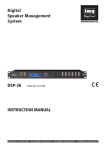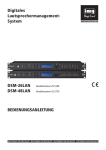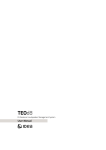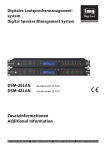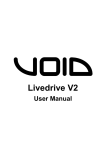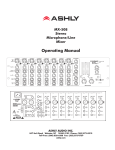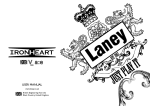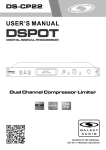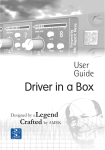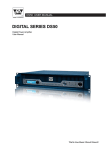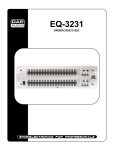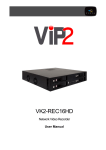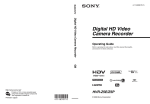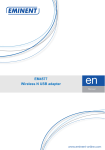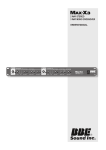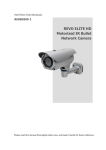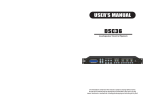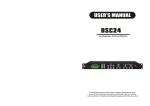Download DSM 26LAN / DSM-48LAN
Transcript
Digital Speaker Management System DSM-26LAN DSM-48LAN Order No. 25.5760 Order No. 25.5770 INSTRUCTION MANUAL ELECTRONICS FOR SPECIALISTS ELECTRONICS FOR SPECIALISTS ELECTRONICS FOR SPECIALISTS ELECTRONICS FOR SPECIALISTS Instruction Manual for DSM-26LAN / DSM-48LAN Introduction Congratulations on the purchase of your DSM-26/-48LAN. IMG Stage Line strives to be the best in high end digital audio processing. After you have become familiar with the processor, we encourage you to experiment and find the most effective and efficient way to run your system by utilizing the powerful processing of the DSM-26/-48LAN. The DSM-26/-48LAN is a powerful speaker management system with 2/4 analog inputs, 2 AES/EBU inputs, 6/8 outputs, 10 PEQ bands per input and output and a frequency range up to 40kHz. The rugged analog input stage accepts input voltages of up to +23dBu thus matching any source on the market today, with an excellent dynamic range of 118dB. Using a 64-bit digital processing and some of the best converters available on the market today, the DSM-26/-48LAN offers sound quality which can compete with whatever your reference unit of choice is. This User Manual describes how to operate the DSM-26/-48LAN's settings via the front panel controls. Alternatively, the DSM-26/-48LAN can be configured completely via a remote connection to a PC or MAC. Please refer to the Software User Manual for details on the remote control application. Controlled via the front panel or via the remote control application, the DSP settings and coefficients are calculated on-the-fly at the moment of changing the parameters. Frequencies can be set with 1Hz accuracy, delays with ten microseconds, accuracy, and gains with 0.01dB accuracy. When editing values via the front panel, some values are limited in granularity; e.g. gain is set via 0.25dB steps in this case. Features: - 118dB dynamic range (inputs) / 114dB dynamic range (outputs) - Electronically balanced inputs - Electronically balanced outputs - Frequency range 20Hz....40kHz - Ten parametric filters per input and output - EQs can be set as Bell, High Shelf, Low Shelf, Notch, Allpass, Band Pass, High Pass, Low Pass - 1000ms delay per input, 20ms delay per output (DSM-26LAN) - 2000ms delay per input, 2000ms delay per output (DSM-48LAN) - Butterworth, Bessel, Linkwitz-Riley filters up to 24dB / oct. - True RMS Compressor - Zero Attack Peak Limiter - Latency 660 microseconds - Full configuration and real-time monitoring via PC or MAC (USB and Ethernet interface) - Integrated 16-character LCD display - 80 Presets - 64 bits multi-mode digital processing Page 2/12 Instruction Manual for DSM-26LAN / DSM-48LAN Safety Instructions WARNING, FOR YOUR PROTECTION READ THE FOLLOWING: The apparatus shall not be exposed to dripping or splashing liquid and no object filled with liquid, such as vases, shall be placed on the apparatus. CLEAN ONLY WITH A DRY CLOTH. DO NOT BLOCK ANY VENTILATION OPENINGS. INSTALL IN ACCORDANCE WITH THE MANUFACTURER´S INSTRUCTIONS. DO NOT INSTALL NEAR ANY HEAT SOURCES SUCH AS RADIATORS, HEAT REGISTERS, STOVES, OR OTHER APPARATUS (INCLUDING AMPLIFIERS) THAT PRODUCE HEAT. ONLY USE ATTACHMENTS/ACCESSORIES SPECIFIED BY THE MANUFACTURER. UNPLUG THIS APPARATUS DURING LIGHTNING STORMS OR WHEN UNUSED FOR LONG PERIODS OF TIME. Do not defeat the safety purpose of the polarized or grounding-type plug. A polarized plug has two blades with one wider than the other. A grounding type plug has two blades and a third grounding prong. The wide blade or third prong is provided for your safety. If the provided plug does not fit your outlet, consult an electrician for replacement of the obsolete outlet. Protect the power cord from being walked on or pinched particularly at plugs, convenience receptacles, and the point where they exit from the apparatus. Use only with the cart stand, tripod bracket, or table specified by the manufacture, or sold with the apparatus. When a cart is used, use caution when moving the cart/apparatus combination to avoid injury from tip-over. Refer all servicing to qualified service personnel. Servicing is required when the apparatus has been damaged in any way, such as power-supply cord or plug is damaged, liquid has been spilled or objects have fallen into the apparatus, the apparatus has been exposed to rain or moisture, does not operate normally, or has been dropped. POWER ON/OFF SWITCH: If the equipment has a Power switch, the Power switch used in this piece of equipment DOES NOT break the connection from the mains. MAINS DISCONNECT: The plug shall remain readily operable. For rack mount or installation where plug is not accessible, an all-pole mains switch with a contact separation of at least 3 mm in each pole shall be incorporated into the electrical installation of the rack or building. FOR PRODUCTS EQUIPPED WITH EXTERNALLY ACCESSIBLE FUSE RECEPTACLE: Replace fuse with same type and rating only. MULTIPLE-INPUT VOLTAGE: This equipment may require the use of a different line cord, attachment plug, or both, depending on the available power source at installation. Connect this equipment only to the power source indicated on the equipment rear panel. To reduce the risk of fire or electric shock, refer servicing to qualified service personnel or equivalent. If connected to 240V supply, a suitable CSA/UL certified power cord shall be used for this supply. This equipment is intended for rack mount use only. WARNING: THIS APPLIANCE SHALL BE CONNECTED TO A MAINS SOCKET OUTLET WITH A PROTECTIVE EARTHING CONNECTION. The cores in the mains lead are colored in accordance with the following code: GREEN and YELLOW - Earth BLUE - Neutral BROWN. Live As colors of the cores in the mains lead of this appliance may not correspond with the colored markings identifying the terminals in your plug, proceed as follows: The core which is colored green and yellow must be connected to the terminal in the plug marked with the letter E, or with the earth symbol, or colored green, or green and yellow. The core which is colored blue must be connected to the terminal marked N or colored black. The core which is colored brown must be connected to the terminal marked L or colored red. This equipment may require the use of a different line cord, attachment plug, or both, depending on the available power source at installation. If the attachment plug needs to be changed, refer servicing to qualified service personnel who should refer to the table below. The green/yellow wire shall be connected directly to the processor´s chassis. WARNING: If the ground is defeated, certain fault conditions in the processor or in the system to which it is connected can result in full line voltage between chassis and earth ground. Severe injury or death can then result if the chassis and earth ground are touched simultaneously. There are dangerous voltages present within the processor. It is necessary for the user to refer to the instruction manual. There are no user serviceable parts inside the processor. Do not open the processor. Do not attempt to service the processor yourself. Refer all servicing to qualified personnel. Opening the chassis for any reason will void the manufacturer´s warranty. Do not get the processor wet. If liquid is spilled on the processor, shut it off immediately and take it to a dealer for service. Disconnect the processor during storms to prevent damage. Page 3/12 Instruction Manual for DSM-26LAN / DSM-48LAN 1.Overview of Connectors and Controls In addition to the available features described in this manual, you also have the option of controlling the DSM with a PC or MAC from a remote location over your network or via a USB cable. Please refer to the Software Manual for details. 1.1.Front Panel 1.1.1.USB Connector The USB connector is used to connect the DSM-26/-48LAN to a PC or MAC. It can then be configured and controlled in real time with the freely available PC and MAC configuration program. With this program you can also update your DSP to the latest firmware. Please check our website regularly for updates. 1.1.2.Input VU Meters There are four independent input meters available. The LEDs indicate: Signal (-48dBu), -6dBu, Limit and Clip. The indication refers to the absolute input level, multiplied with the input gain. The Limit LED lights when any gain reduction is taking place in that channel. The CLIP LED lights when the input level reaches +22dBu. 1.1.3.Function Buttons The function buttons allow direct access to all editing and navigating functions. See section three for a detailed description on the functions of each of these buttons. 1.1.4.Rotary Encoder The rotary encoder is used to scroll through the menu items by pushing it, and to adjust values by rotating it. When values are changed, the DSP is updated in real-time. 1.1.5.Output VU Meters There are six independent output VU meters available. The LEDs indicate: Signal (-48dBu), -6dBu, Limit and Clip. The indication refers to the output level w.r.t. the threshold of the output peak limiter. The Limit LED lights when any gain reduction is taking place in that channel. The CLIP LED lights when more than 12dB of gain reduction is taking place. 1.1.6.Output Mute Buttons The six output mute buttons are used for independently muting each output. Page 4/12 Instruction Manual for DSM-26LAN / DSM-48LAN 1.2.Rear Panel 1.2.1.Power Connector The DSM-26/-48LAN has an internal power supply that will accept voltages ranging from 200V - 240V and frequencies from 50Hz-60Hz. An IEC cord is included. 1.2.2.Power Switch The Power Switch turns the DSM-26/-48LAN on and off. Note: we recommend that power amplifiers connected to the product, should be powered down prior to cycling the power of this product. 1.2.3.Ethernet Connector This RJ-45 connector is used to connect your product to a network. It can then be configured and controlled in real time with the freely available PC and MAC configuration program. With this program you can also update your DSP to the latest firmware. Please check our website regularly for updates. 1.2.4.Analog inputs The analog input section of the DSM-26/-48LAN offers 2/4 electronically balanced XLR connectors. The input level is +23dBu max (11V eff.). 1.2.5.Analog Outputs The output section of the DSM-26/-48LAN offers 6/8 electronically balanced XLR connectors. The output level is +12dBu max (4V eff.). 1.2.6.AES/EBU Inputs The digital input of the DSM-26/-48LAN offers two input channels (stereo) on an balanced XLR connector. The processor will accept AES/EBU signals (balanced) and S/PDIF signals (unbalanced) of 16 to 24 bit resolution and 44.1, 48, 88.2, or 96kHz sample frequency. Page 5/12 Instruction Manual for DSM-26LAN / DSM-48LAN 2.Getting Started 2.1.Quick Start For those of you that wish to jump right in, the following information has been provided to act as a quick start guide for optimizing performance of your processor. 2.2.Connections 2.2.1.Signal Connections When setting up your processor, make connections as follows: - Always make connections prior to applying power to the processor. - Connect the output(s) from the sending device (mixer) to the CH1 XLR input connector (mono) or both, CH1 and CH2 XLR input connectors (stereo). - Make output connections from the output XLR connector(s) to the input connector(s) of the selected power amplifier(s). Always make sure that your power amps are the last item turned on and the first turned off. Once all of the connections have been made, and the processor is powered up, you can navigate through the entire signal path of your processor from the front panel. The display provides you with a clear and concise overview of each aspect of the signal path from the input (left side of display) to the output section (right side of display). 2.2.2.Remote Monitoring and Control For the quickest and easiest results we recommend to install and use the freely available PC or MAC configuration software. It provides a complete and comprehensive tool to make your loudspeaker configuration settings, and to manage your presets. When connecting the unit via USB, make sure to connect it directly to your computer or to use a USB hub that supports USB1.0. If you have problems with the USB connection, please refer to the Installation Guide for details on how to install the proper driver. When connecting the unit via an Ethernet network, you have several options. The PC/MAC application has an auto-discovery tool that will automatically connect to any unit found on the network. Please refer to the Software Manual available on our website for details on the control software. 2.2.2.1.Standard DHCP Network For the easiest connection, use a standard Ethernet Router, plug in the unit and your computer, and the connection should be made automatically. Standard routers have a DHCP server built in and enabled. A DHCP server assigns a network address to your computer and to the DSM-26/-48LAN, allowing them to connect automatically. 2.2.2.2.Connection without DHCP server Alternatively, you can use a direct (cross) cable or a simple Ethernet Switch to connect the unit to your PC or MAC. Please note that in this case, especially Windows computers may take up to several minutes to assign themselves a network address (indicated by the text: "This connection has limited or no connectivity"). The computer and the DSM-26/-48LAN both will assign themselves a network address in the ZeroConfig range (169.254.0.0 - 169.254.255.255), and the DSM-26/-48LAN will be discovered automatically by the PC/MAC application. To facilitate connections without DHCP router, it may be convenient to set your computer to a fixed IP address. If you do this, please choose any address in the ZeroConfig range, and set the subnet mask to 255.255.0.0. Page 6/12 Instruction Manual for DSM-26LAN / DSM-48LAN 2.2.2.3.Fixed IP address It is also possible to set a fixed IP address and subnet mask for the DSM-26/-48LAN. WARNING: If you set a wrong address (in a different range than your computer), you may not be able to connect anymore. It is STRONGLY RECOMMENDED to consult a system administrator before making such settings. 2.2.2.4.Firewall After starting the software application for the first time, your computer may ask you to allow or block the application access to the network. Please make sure to allow this; if there is a firewall between the application and the DSM-26/-48LAN, the application will not find the DSM-26/-48LAN. 2.3.System Setup and Gain Structure This product offers a wide range of tools for sound system design and setup. These tools can make your system more efficient and better sounding, but to get the best possible sound it is important to use these tools properly. The following section explains how to maximize system gain and how to use the limiters to protect your amplifiers from clipping. In traditional system design, the output of your console would be routed to a system EQ, a compressor, and a crossover with output level control. From the crossover, there may be additional filters that are employed to improve the response of your speakers. There may also be limiters set up to keep your amplifiers from going into clipping and protect your speakers from the hazards of a clipped signal. Your amplifiers play a vital role in system setup, because they are last item in the chain before your speakers and offer the greatest amount of gain (that is their job after all). If your limiters and amplifiers are incorrectly setup you will not be using your system to its fullest potential and could be harming your speakers. To ensure an optimal gain structure: Play a signal at the nominal level from your mixing desk, and set the input gain of your processor to 0. Set the crossovers that you want to use, while keeping the output gains also at 0. With DISCONNECTED loudspeakers, turn up the volume of the power amplifiers entirely clockwise (full volume). Now reduce the output gain and / or the output limiter setting to get the desired gain, so that the amplifier is just clipping and the built-in limiters of your processor are just limiting. If the amplifier does not have a built-in clip limiter, set your processor's limiter so that the amplifier does not clip. Now turn down the volume of the power amplifiers, connect your speakers, and slowly increase the volume while checking the sound. If all is well, there should be distortion-free sound, and the limiter LEDs are flashing or off, but not continuously on. If they are continuously on, reduce the output gain of your processor. If you can not reach enough signal level, increase the processor's input gain or turn up the level from your mixing desk. Page 7/12 Instruction Manual for DSM-26LAN / DSM-48LAN 3.Setup And Operation Before plugging the processor in, always make sure that the power supply matches the product specification voltage. Install this device on a flat, stable surface, not bend or curved. Do not supply power before all components of the system are set up and connected properly. Make sure to power-up your device before your power amplifiers are switched on in order to avoid transients, which could damage your speakers or annoy your audience. 3.1.System Check After connecting all cables, you should mute all outputs first or turn the gain/level setting on your amplifiers to minimum. Activate the HF-outputs first. In case of wrong cabling, High Frequency (HF) audio signals will come out of bass-speakers that cannot be harmed this way. Vice versa, the Low Frequency (LF) audio signals would destroy your HF-speakers. It is advisable to install a large capacitor in series with HF drivers (47 - 100 uF). That way, drivers are somewhat protected against accidental instrumentation errors. 3.2.Input Setup Press the Channel Up or Down button to select the input channel you wish to edit. Make the first settings with the output turned low or muted. To toggle through the different items, press the Item Up or Item Down buttons. 3.2.1.Gain Adjust the gain by dialing the rotary encoder. The gain is adjusted in steps of 0.25dB. Smaller steps (0.01dB) can be set via the PC or MAC interface. 3.2.2.Input Selection Select the source (Analog or AES/EBU) by rotating the encoder. 3.2.3.Delay Set the delay time by turning the encoder. Select the displayed unit (ms or s, mm or m, feet, inches, or mils) by pushing the encoder. 3.2.4.Low Pass Filter Adjust the Low Pass Filter frequency by turning the rotary encoder. You can switch the low pass filter off by turning the rotary encoder up (clockwise) until the frequency passes 20kHz. Press the rotary encoder to change the filter type. Select the type by turning the rotary encoder. You can choose from: Butterworth 6dB, Bessel 6dB, Butterworth 12dB, Bessel 12dB, Linkwitz Riley12dB, Butterworth 18dB, Bessel 18dB, Butterworth 24dB and Bessel 24dB. Higher order filters may be set by adding filter sections in the PEQ blocks (see below). Page 8/12 Instruction Manual for DSM-26LAN / DSM-48LAN 3.2.5.High Pass Filter Adjust the high pass frequency by dialing the rotary encoder. You can switch the high pass filter off by dialing the rotary encoder down (counterclockwise) until the frequency passes 20Hz. Press the rotary encoder to change the filter type. Select the type by turning the rotary encoder. You can choose from: Butterworth 6dB, Bessel 6dB, Butterworth 12dB, Bessel 12dB, Linkwitz Riley12dB, Butterworth 18dB, Bessel 18dB, Butterworth 24dB and Bessel 24dB. Higher order filters may be set by adding filter sections in the PEQ blocks (see below). 3.2.6.Parametric Equalizer (PEQ) There are ten bands of parametric equalization. Each band can be adjusted freely over the complete frequency range of 20Hz to 20kHz. Adjust the frequency by dialing the rotary encoder. Press the rotary encoder to select the parameters. The available parameters are: Frequency (20Hz to 20kHz), Gain (-12dB to +12dB), Q (0.2 to 25), Enabled (On or Off), Type (Bell, High Shelf, Low Shelf, Notch, All Pass, Band Pass, High Pass, Low Pass). For the Shelving filters, the Q value sets the steepness of the filter in dB/Oct. 3.2.7.Compressor The compressor is a true RMS compressor. Turn the rotary encoder to set the threshold. Press the rotary encoder to select the parameters. The available parameters are: Threshold, Attack, Hold, Release, Ratio, and Makeup Gain. 3.2.8.Limiter The limiter is a zero-attack peak limiter. Only the threshold and release can be set. Press the rotary encoder to select the parameters. The release value is displayed in dB per second. 3.2.9.Channel Link By linking 2 channels, the settings are guaranteed to be identical for both channels, except for mixer and mute. Turn the encoder to set the Channel Link on or off. Page 9/12 Instruction Manual for DSM-26LAN / DSM-48LAN 3.3.Output Setup Press the Channel Up or Down button to select the output channel you wish to edit. Make the first settings with the output turned low or muted. To toggle through the different items, press the Item Up or Item Down buttons. 3.3.1.Gain Adjust the gain by dialing the rotary encoder. The gain is adjusted in steps of 0.25dB. Smaller steps (0.01dB) can be set via the PC or MAC interface. 3.3.2.Mixer Turn the rotary encoder to mix the signal from the selected input to the selected output. Push the rotary encoder to select the input. Attention: The mixer is only available while the outputs are not linked by Channel Link. If the channels are linked, the mixer will be skipped. 3.3.3.Delay Set the delay time by turning the encoder. Select the displayed unit (ms or s, mm or m, feet, inches, or mils) by pushing the encoder. 3.3.4.Low Pass Filter Adjust the Low Pass Filter frequency by turning the rotary encoder. You can switch the low pass filter off by turning the rotary encoder up (clockwise) until the frequency passes 20kHz. Press the rotary encoder to change the filter type. Select the type by turning the rotary encoder. You can choose from: Butterworth 6dB, Bessel 6dB, Butterworth 12dB, Bessel 12dB, Linkwitz Riley12dB, Butterworth 18dB, Bessel 18dB, Butterworth 24dB and Bessel 24dB. Higher order filters may be set by adding filter sections in the PEQ blocks (see below). 3.3.5.High Pass Filter Adjust the high pass frequency by dialing the rotary encoder. You can switch the high pass filter off by dialing the rotary encoder down (counterclockwise) until the frequency passes 20Hz. Press the rotary encoder to change the filter type. Select the type by turning the rotary encoder. You can choose from: Butterworth 6dB, Bessel 6dB, Butterworth 12dB, Bessel 12dB, Linkwitz Riley12dB, Butterworth 18dB, Bessel 18dB, Butterworth 24dB and Bessel 24dB. Higher order filters may be set by adding filter sections in the PEQ blocks (see below). Page 10/12 Instruction Manual for DSM-26LAN / DSM-48LAN 3.3.6.Parametric Equalizer (PEQ) There are ten bands of parametric equalization. Each band can be adjusted freely over the complete frequency range of 20Hz to 20kHz. Adjust the frequency by dialing the rotary encoder. Press the rotary encoder to select the parameters. The available parameters are: Frequency (20Hz to 20kHz), Gain (-12dB to +12dB), Q (0.2 to 25), Enabled (On or Off), Type (Bell, High Shelf, Low Shelf, Notch, All Pass, Band Pass, High Pass, Low Pass). For the Shelving filters, the Q value sets the steepness of the filter in dB/Oct. 3.3.7.Compressor The compressor is a true RMS compressor. Turn the rotary encoder to set the threshold. Press the rotary encoder to select the parameters. The available parameters are: Threshold, Attack, Hold, Release, Ratio, and Makeup Gain. 3.3.8.Limiter The limiter is a zero-attack peak limiter. Only the threshold and release can be set. Press the rotary encoder to select the parameters. The release value is displayed in dB per second. 3.3.9.Phase Inversion Turn the rotary encoder to switch phase inversion on or off. 3.3.10.Channel Link By linking 2 channels, the settings are guaranteed to be identical for both channels, except for mixer and mute. Turn the encoder to set the Channel Link on or off. Page 11/12 Instruction Manual for DSM-26LAN / DSM-48LAN 3.4.System Menu Push the Menu button to enter the system menu. Push the Menu button again to toggle through the menu items. The available menu items are: 3.4.1.Load Preset Turn the rotary encoder to select the preset you wish to load. Push the rotary encoder to select it, then turn it again to select "YES" and confirm again by pushing the rotary encoder knob. The preset is loaded and all settings are applied immediately. All settings that were in the unit prior to loading the preset will be erased. This action can not be undone. The presets contain all filter, dynamics, gain settings etc; in other words, everything that makes out a loudspeaker configuration. Presets do NOT contain the name of the unit, network configuration, automatic standby delay, user access rights and passwords. 3.4.2.Save Preset Turn the rotary encoder to select the location of the preset. If that location is not empty, the preset in that location will be overwritten. This action can not be undone. The system will ask you to give a name to the preset name. Select a character in the cursor position by turning the rotary encoder; pushing the rotary encoder confirms the character selected and moves the cursor to the next character to edit. Pushing the exit/ESC button erases the last confirmed character. Once the name is set up, push the menu button again. If you want to continue storing the preset, select Yes by turning the rotary encoder and confirm by pushing it. To cancel, push the exit button. Now your preset is saved in the selected location. The presets contain all filter, dynamics, gain settings etc; in other words, everything that makes out a loudspeaker configuration. Presets do NOT contain the name of the unit, network configuration, automatic standby delay, user access rights and passwords. 3.4.3.Access Level The DSM-26/-48LAN has the option of locking away the front panel controls to avoid tampering of settings by unauthorized persons. To lock the unit, select "Locked" by turning the rotary encoder, and push it to confirm. The system will ask you to enter a password. Select a character in the cursor position by turning the rotary encoder; pushing the rotary encoder confirms the character selected and moves the cursor to the next character to edit. Pushing the exit/ESC button erases the last confirmed character. Once the password is set up, push the menu button again and the unit will be locked. ATTENTION: Make sure to remember the password! When the unit is locked and you forgot the password, it is not possible to unlock it without contacting your local service representative. To unlock the unit select "Unlocked" and enter the password. The password is automatically checked after each entered character, and the unit will exit the system menu when the password is confirmed. The default password is "Password". 3.4.4.Version Information By pushing the rotary encoder, the display toggles through some version information about the unit, as well as some parameters like IP address, MAC address etc. Page 12/12












